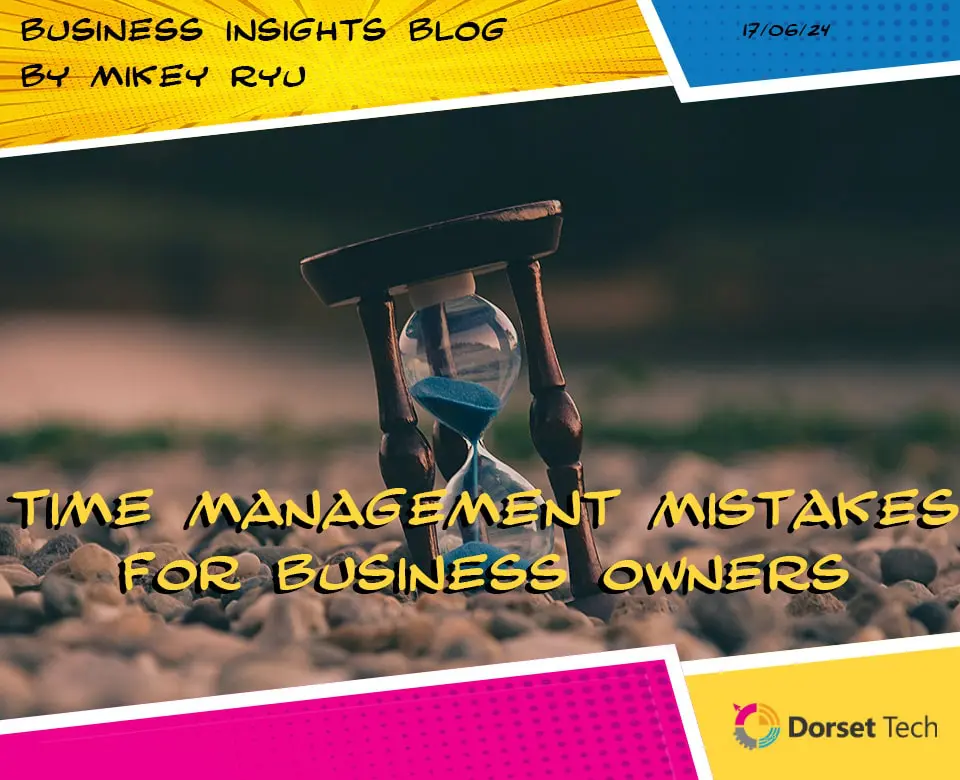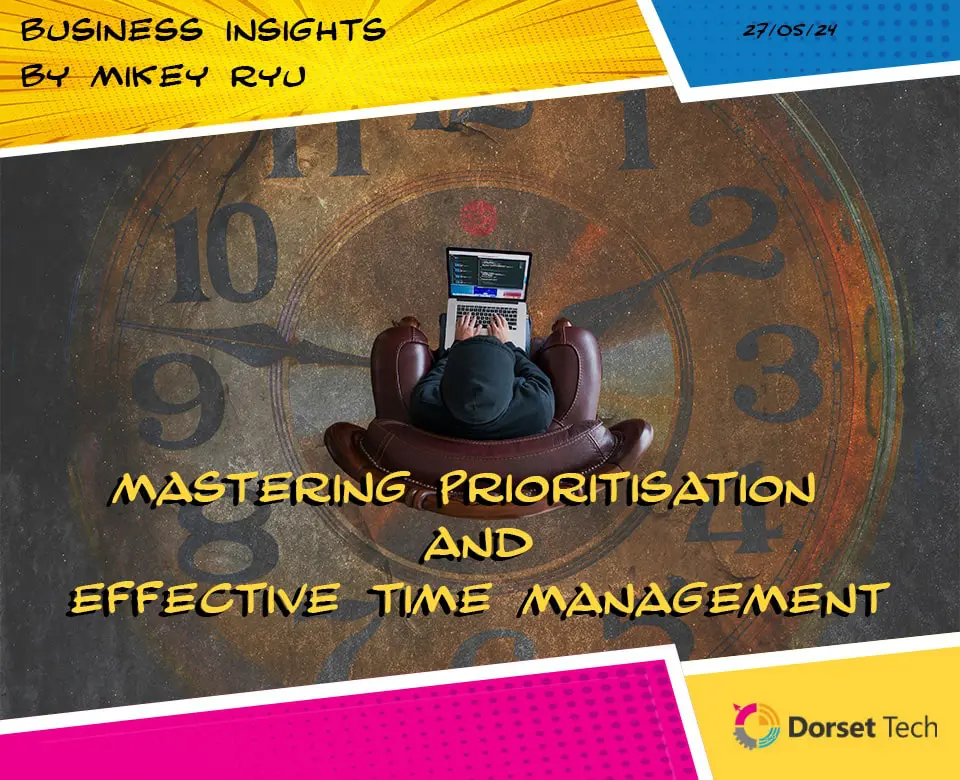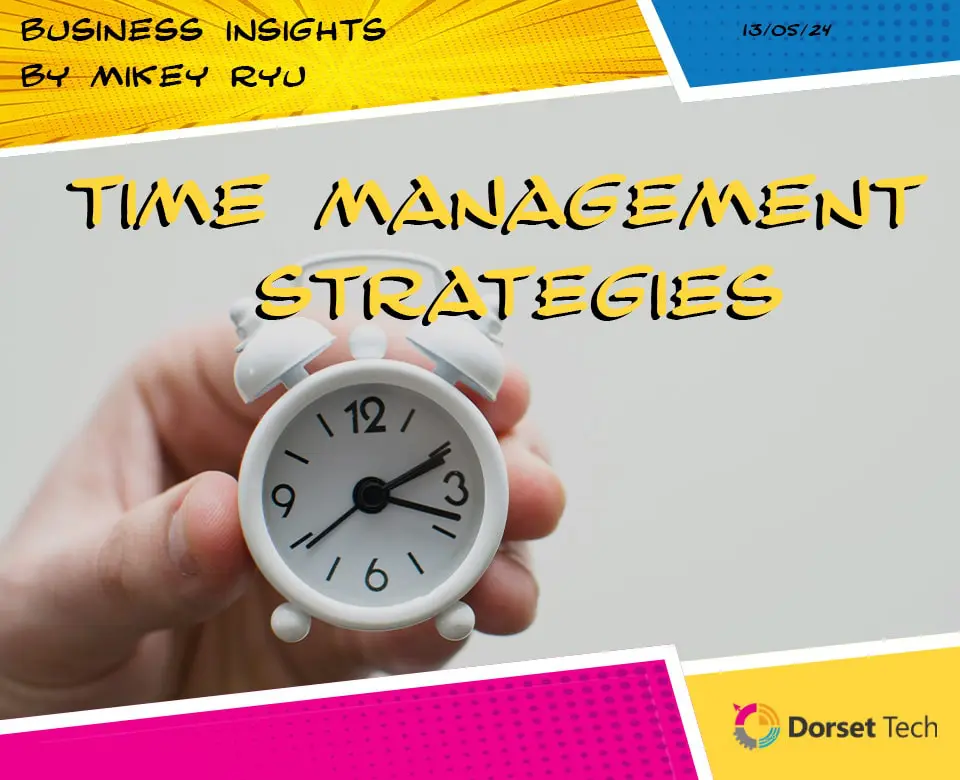
Managing Your Workflow
Workflow management is a crucial skill for anyone working within a company. The ability to efficiently and effectively manage tasks is incredibly valuable in the workplace, enabling you to accomplish more than most. Effective workflow management brings numerous benefits, not just for individuals but for teams as well. These benefits include increased productivity, improved efficiency, enhanced collaboration, reduced stress, better quality control, greater transparency, enhanced flexibility and adaptability, improved time management, cost savings, and continuous improvement. By incorporating workflow management into your daily routine, you can significantly boost the amount of work you accomplish in a day.
Understanding Workflow Management:
Workflow management is a crucial skill for anyone working inside a company. The ability to efficiently and effectively manage your tasks can be an incredibly helpful skill in the workplace and can allow you to get more than most do. Effective workflow management brings about many benefits not just for you but your team as well, these include:
- Increased Productivity:
- Improved Efficiency:
- Enhanced Collaboration:
- Reduced Stress:
- Better Quality Control:
- Greater Transparency:
- Enhanced Flexibility and Adaptability:
- Improved Time Management:
- Cost Savings:
- Continuous Improvement:
By implementing workflow management into your daily routine you can boost the amount of work that you can get done in one day.
Common Workflow Challenges:
Despite the many benefits of effective workflow management, several challenges can hinder its implementation. Understanding these common obstacles can help individuals and organisations address them proactively:
Lack of Clear Priorities:
- Without clear prioritisation, tasks can become overwhelming and lead to inefficiency.
- Important tasks may be overlooked while less critical tasks consume valuable time.
Poor Communication:
- Ineffective communication can result in misunderstandings and misaligned goals.
- A lack of collaboration tools or channels can exacerbate these issues, leading to delays and errors.
Inadequate Resource Allocation:
- Misallocation of resources, such as time, personnel, and budget, can disrupt workflow.
- Overloading some team members while underutilising others can create bottlenecks.
Resistance to Change:
- Employees may resist new workflow processes or tools due to comfort with existing methods.
- Change management strategies are essential to overcome this resistance and encourage adoption.
Lack of Training and Support:
- Insufficient training on new systems or processes can hinder effective workflow management.
- Ongoing support and resources are crucial to help team members adapt and excel.
Inefficient Processes:
- Outdated or cumbersome processes can slow down workflow and decrease productivity.
- Regular process reviews and updates are necessary to maintain efficiency.
Technology Integration Issues:
- Integrating new tools with existing systems can be complex and time-consuming.
- Technical glitches or incompatibilities can disrupt workflow and frustrate users.
Unrealistic Deadlines:
- Setting unattainable deadlines can cause stress and reduce the quality of work.
- Proper planning and realistic timelines are essential for sustainable productivity.
Lack of Flexibility:
- Rigid workflows may not accommodate unexpected changes or new priorities.
- Flexibility and adaptability are key to managing dynamic work environments.
Overlapping Responsibilities:
- Ambiguous roles and responsibilities can lead to duplicated efforts or tasks falling through the cracks.
- Clear delineation of duties helps prevent confusion and ensures accountability.
Addressing these common workflow challenges requires a combination of strategic planning, effective communication, and the right tools and technologies. By recognising and tackling these obstacles, organisations can enhance their workflow management and achieve better outcomes.
Prioritisation Techniques:
The Eisenhower Matrix:
The Eisenhower Matrix, also known as the Urgent-Important Matrix, is a powerful prioritisation tool that helps individuals and teams manage tasks based on their urgency and importance. Named after former U.S. President Dwight D. Eisenhower, who famously said, “What is important is seldom urgent, and what is urgent is seldom important,” this matrix provides a clear framework for decision-making.
How the Eisenhower Matrix Works
The Eisenhower Matrix divides tasks into four quadrants based on their urgency and importance:
- Quadrant 1: Urgent and Important
- Tasks that require immediate attention and are critical to achieving significant goals.
- Examples: Crisis situations, pressing deadlines, and urgent problems that cannot be ignored.
- Quadrant 2: Not Urgent but Important
- Tasks that are essential for long-term success but do not require immediate action.
- Examples: Strategic planning, personal development, relationship building, and preventive measures.
- Quadrant 3: Urgent but Not Important
- Tasks that need immediate attention but are not crucial to achieving major goals.
- Examples: Interruptions, most emails, some meetings, and minor issues.
- Quadrant 4: Not Urgent and Not Important
- Tasks that are neither urgent nor important and often serve as distractions.
- Examples: Time-wasting activities, trivial tasks, and excessive entertainment.
Best Way to Use the Eisenhower Matrix
To effectively use the Eisenhower Matrix, follow these steps:
- List Your Tasks:
- Write down all the tasks you need to accomplish. Include both personal and professional tasks to get a comprehensive view of your responsibilities.
- Categories Each Task:
- Assign each task to one of the four quadrants based on its urgency and importance. Be honest and critical in your assessment to ensure accurate categorization.
- Prioritise Quadrant 1 Tasks:
- Focus on completing urgent and important tasks first. These are critical to your immediate success and require prompt attention.
- Schedule Quadrant 2 Tasks:
- Allocate specific time slots for important but not urgent tasks. These activities are crucial for long-term success and should not be neglected.
- Delegate Quadrant 3 Tasks:
- Identify tasks that are urgent but not important and delegate them if possible. This allows you to focus on more critical activities while ensuring these tasks are still addressed.
- Eliminate or Minimise Quadrant 4 Tasks:
- Avoid or limit tasks that fall into the not urgent and not important category. These activities are distractions that hinder productivity and should be minimised.
- Regularly Review and Adjust:
- Periodically review your task list and reassess the categorisation as priorities and circumstances change. This ensures that your workflow remains aligned with your goals.
By consistently applying the Eisenhower Matrix, you can effectively prioritise your tasks, manage your time better, and enhance your overall productivity. This structured approach helps you focus on what truly matters, reduces stress, and fosters a more organised and efficient workflow.
ABC Method:
The ABC Method is a simple yet effective prioritisation technique that categorises tasks based on their importance and impact. By assigning tasks to different priority levels, this method helps individuals and teams focus on what truly matters and manage their time more efficiently.
How the ABC Method Works
The ABC Method divides tasks into three categories:
- Category A: High Priority (Must-Do)
- Tasks that are critical to achieving your most important goals and have significant consequences if not completed.
- Examples: Key project deadlines, major client meetings, and essential strategic decisions.
- Category B: Medium Priority (Should-Do)
- Tasks that are important but not as critical as Category A tasks. They contribute to your goals but have less immediate impact.
- Examples: Routine check-ins, ongoing project tasks, and activities that support long-term objectives.
- Category C: Low Priority (Nice-to-Do)
- Tasks that are beneficial but have the least impact on your goals and can be deferred or delegated.
- Examples: Minor administrative work, optional meetings, and non-essential correspondence.
Best Way to Use the ABC Method
To effectively use the ABC Method, follow these steps:
- List Your Tasks:
- Write down all the tasks you need to accomplish. Make sure to include both urgent and non-urgent tasks to get a complete picture of your workload.
- Assign Priorities:
- Categorise each task as A, B, or C based on its importance and impact. Be honest and objective to ensure accurate prioritisation.
- Focus on Category A Tasks:
- Concentrate on completing high-priority tasks first. These are essential for your success and should be tackled with the most focus and effort.
- Plan for Category B Tasks:
- Allocate specific time slots in your schedule for medium-priority tasks. While not as urgent, these tasks are still important and should not be neglected.
- Handle Category C Tasks:
- Address low-priority tasks when time permits, or consider delegating them to others. These tasks can often be postponed without significant consequences.
- Review and Adjust Regularly:
- Periodically review your task list and adjust the priorities as needed. This ensures that your prioritisation remains aligned with changing goals and circumstances.
- Use Tools for Organisation:
- Utilise tools such as to-do lists, planners, or digital task management apps to organise and track your tasks according to their priority levels.
- Evaluate Task Completion:
- Reflect on the completion of your tasks and assess the effectiveness of your prioritisation. Learn from any challenges and make adjustments to improve your workflow.
By consistently applying the ABC Method, you can streamline your task management, focus on what truly matters, and enhance your overall productivity. This method helps you allocate your time and resources more effectively, ensuring that high-priority tasks receive the attention they deserve while lower-priority tasks are managed appropriately.
MoSCoW Method:
The MoSCoW Method is a prioritisation technique commonly used in project management to categorise tasks and requirements based on their importance. This method helps teams focus on delivering the most critical elements of a project first, ensuring that essential needs are met while allowing flexibility for less critical aspects.
How the MoSCoW Method Works
The MoSCoW Method divides tasks into four categories:
- Must Have:
- Tasks or requirements that are absolutely essential for the project’s success. Without these, the project would fail or be incomplete.
- Examples: Core features of a software application, critical project deadlines, and essential compliance requirements.
- Should Have:
- Tasks or requirements that are important but not vital. These should be included if possible but are not absolutely critical for the initial delivery.
- Examples: Secondary features that enhance user experience, additional documentation, and quality improvements.
- Could Have:
- Tasks or requirements that are desirable but not necessary. These can be included if time and resources permit but can be omitted without impacting the project’s success.
- Examples: Nice-to-have features, cosmetic enhancements, and extra options.
- Won’t Have (or Would Have):
- Tasks or requirements that are agreed to be deferred for future releases. These are not considered for the current project scope but may be revisited later.
- Examples: Future enhancements, non-critical features, and long-term goals.
Best Way to Use the MoSCoW Method
To effectively use the MoSCoW Method, follow these steps:
- Identify and List Requirements:
- Write down all tasks or requirements for your project. This comprehensive list should include everything from essential needs to potential enhancements.
- Categories Each Requirement:
- Assign each task or requirement to one of the four MoSCoW categories (Must Have, Should Have, Could Have, Won’t Have). Be thorough and consider the impact of each item on the project’s success.
- Focus on Must-Have Requirements:
- Prioritise and ensure that all Must-have tasks are completed first. These are critical to the project’s success and must be delivered within the project timeline.
- Plan for Should Have Requirements:
- Schedule time and resources for Should Have tasks after Must Have tasks are addressed. Aim to include as many of these as possible without compromising on the Must Haves.
- Consider Could Have Requirements:
- Address Could Have tasks if time and resources permit. These tasks are not critical but can add value to the project if included.
- Document Won’t Have Requirements:
- Clearly document tasks that fall into the Won’t Have category. These items are not part of the current project scope but may be considered for future phases or projects.
- Review and Adjust Regularly:
- Periodically review the categorisation of tasks as the project progresses. Adjust priorities as needed based on changes in project scope, deadlines, or resources.
- Communicate Clearly with Stakeholders:
- Ensure that all stakeholders understand the MoSCoW prioritisation and agree on the categorisation of tasks. Clear communication helps manage expectations and align goals.
- Use Tools for Tracking:
- Utilise project management tools to track and manage tasks according to their MoSCoW categories. Tools like Trello, Jira, or Asana can help visualise and monitor progress.
By consistently applying the MoSCoW Method, you can effectively prioritise project tasks, ensure critical requirements are met, and maintain flexibility for less critical aspects. This structured approach helps manage scope, time, and resources efficiently, leading to more successful project outcomes.
Integrating These Techniques:
Integrating prioritisation techniques such as the Eisenhower Matrix, ABC Method, and MoSCoW Method into your workflow management can significantly enhance productivity and efficiency. Each method offers unique advantages, and combining them allows for a comprehensive approach to task and project management. Here’s how to effectively integrate these techniques:
Step 1: Understand Your Needs
- Assess Your Tasks and Projects:
- Start by listing all tasks and projects you need to manage. Understanding the scope and requirements is crucial for selecting the right prioritisation techniques.
- Determine Prioritisation Criteria:
- Identify the criteria that matter most for your workflow. This could be urgency, importance, impact, or a combination of these factors.
Step 2: Apply the Eisenhower Matrix
- Categories Tasks by Urgency and Importance:
- Use the Eisenhower Matrix to sort tasks into four quadrants: Urgent and Important, Not Urgent but Important, Urgent but Not Important, and Not Urgent and Not Important.
- Focus on High-Priority Quadrants:
- Concentrate on tasks in the Urgent and Important quadrant first, followed by the Not Urgent but Important quadrant. Delegate or minimise tasks in the other two quadrants.
Step 3: Implement the ABC Method
- Assign ABC Categories:
- Further refine your prioritised list by categorising tasks into A (High Priority), B (Medium Priority), and C (Low Priority) based on their importance and impact.
- Plan and Schedule:
- Schedule time to complete A tasks first, followed by B tasks, and finally C tasks. This ensures that you are focusing on the most critical tasks.
Step 4: Use the MoSCoW Method for Projects
- Categorise Project Requirements:
- For larger projects, use the MoSCoW Method to categorise requirements into Must Have, Should Have, Could Have, and Won’t Have. This helps prioritize project features and deliverables.
- Align with Eisenhower and ABC:
- Ensure that Must Have requirements align with your A tasks in the ABC Method and fall within the Urgent and Important quadrant of the Eisenhower Matrix.
Step 5: Create a Unified Prioritisation Framework
- Combine Insights from All Techniques:
- Develop a unified prioritisation framework that incorporates elements from all three techniques. This can be a matrix or a hierarchical list that clearly outlines task priorities.
- Use Tools for Integration:
- Utilise task management and project management tools that support multiple prioritisation techniques. Tools like Trello, Asana, or Jira can help you visualise and manage tasks effectively.
Step 6: Review and Adjust Regularly
- Periodic Reviews:
- Regularly review your prioritisation framework to ensure it remains aligned with your goals and project requirements. Adjust priorities as needed based on feedback and changing circumstances.
- Gather Feedback:
- Collect feedback from team members and stakeholders to identify areas for improvement. Use this feedback to refine your prioritisation process.
Step 7: Communicate and Collaborate
- Share Prioritisation with Team Members:
- Ensure that your team understands and adopts the integrated prioritisation techniques. Clear communication helps maintain alignment and focus.
- Collaborate Effectively:
- Foster a collaborative environment where team members can contribute to prioritisation decisions. This ensures buy-in and collective ownership of the workflow.
By integrating the Eisenhower Matrix, ABC Method, and MoSCoW Method, you can create a robust prioritisation framework that addresses both individual tasks and larger project requirements. This comprehensive approach enhances productivity, ensures critical tasks are prioritised, and provides the flexibility needed to adapt to changing circumstances.
In conclusion, mastering workflow management is essential for achieving higher productivity and efficiency in any professional setting. While common challenges such as lack of clear priorities, poor communication, and inadequate resource allocation can hinder effective workflow, adopting structured prioritisation techniques can help overcome these obstacles. Techniques like the Eisenhower Matrix, ABC Method, and MoSCoW Method provide clear frameworks for managing tasks and projects based on urgency, importance, and impact. By integrating these techniques, individuals and teams can create a robust prioritisation system that ensures critical tasks are completed first, resources are allocated effectively, and projects are delivered successfully. Embracing these strategies will lead to a more organised, productive, and adaptable work environment, enabling both personal and organisational growth.





















